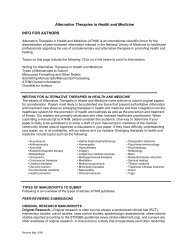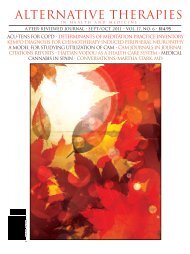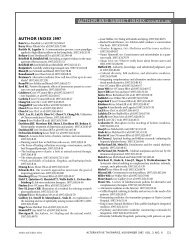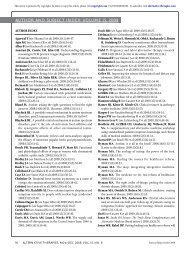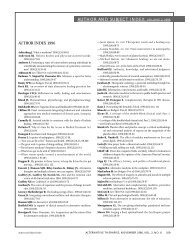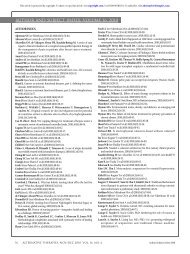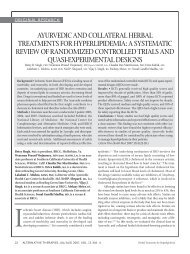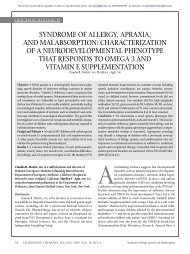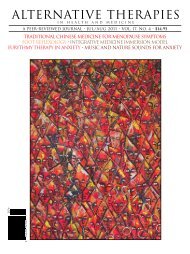Alternative Therapies In Health And Medicine
Alternative Therapies In Health And Medicine
Alternative Therapies In Health And Medicine
Create successful ePaper yourself
Turn your PDF publications into a flip-book with our unique Google optimized e-Paper software.
She had experienced a psychological trauma in her childhood years<br />
and already then had suffered from several symptoms of anxiety.<br />
Both are well-known risk factors for the development of anxiety disorder.<br />
9 The diagnosis had been confirmed independently by three<br />
attending physicians and also by a psychiatrist assessing the<br />
patient’s journals from both the Family Physician Care Centre of the<br />
Vidarkliniken and from the adjacent Psychiatric Outpatient Care<br />
for Young People. A subclassification of the anxiety syndrome had<br />
not then been done; it may have been a generalized anxiety disorder,<br />
but it also may have overlapped with other anxiety disorders.<br />
The additional diagnosis within the AM paradigm (Sidebar)<br />
pointed out a disturbance of the rhythmic system, possibly induced<br />
by a psychological trauma during the susceptible age period<br />
between 7 and 14 years of age. This diagnosis was confirmed by the<br />
EYT-therapist when assessing the patient’s EYT-specific patterns of<br />
gestures and movements.<br />
The therapeutic intention of EYT was to treat the rhythmic<br />
system disturbance and by doing so, alleviate the anxiety and support<br />
the patient’s resilience. Accordingly, the exercises were chosen<br />
to influence the disturbed rhythmic functions: directly through specific<br />
rhythmical and expressive movement exercises and indirectly<br />
through consonant exercises to loosen tension. The therapist<br />
repeatedly observed an immediate transition of the indicated exercise<br />
movements into the patient’s own movement and gesture patterns.<br />
Out of the exercises, the patient’s movements became not<br />
only more fluent, flexible, elastic, and rhythmical, but also softer,<br />
lighter, and peaceful; increased relaxation became visible in different<br />
regions of the body. The body regions became integrated into<br />
the movement so that the patient experienced herself as a whole<br />
and showed increased expressiveness and self-confidence. Over the<br />
total course of the treatment, these improvements were successfully<br />
additive. They were paralleled by a very fast and marked improvement<br />
of anxiety symptoms and social functioning. The woman<br />
became socially active again and could resume work.<br />
Treating anxiety disorders with a movement therapy that contains<br />
elements of art, relaxation, and meditation is also known in<br />
other therapeutic approaches. Psychological treatments are well<br />
established for this condition, and relaxation techniques, dance and<br />
movement therapies, autogenic training, meditation, and self-help<br />
approaches are frequently used and do show some evidence of effectiveness<br />
in clinical studies. 28,29 It has been pointed out that the effects<br />
of pharmacological treatments are often disappointing and limited<br />
to the timespan of actual medicine intake, and relapse is frequent<br />
after drugs are withdrawn. 10,12-16 Patients often seek complementary,<br />
especially cognitive and other nonpharmacological, treatments and<br />
may also prefer a nonverbal, artistic therapy. 17,28<br />
<strong>In</strong> our case, concomitant treatments, spontaneous improvement,<br />
and context effects have to be considered as potential confounders:<br />
The young woman had received supportive counseling as<br />
an outpatient at a psychiatric clinic. The counseling, however, had<br />
begun 3 months before and had not led to any improvement of the<br />
patient’s functional capacity. On the other hand, the functional<br />
capacity improved quickly after the onset of EYT, which one would<br />
not have expected considering the previous duration of the disorder<br />
Anthroposophic Concept of the Human<br />
Organism and Pathogenesis<br />
I. The Four-level Concept of Formative Forces 20<br />
The anthroposophic concept of man claims that the<br />
human organism is not only formed by physical (cellular,<br />
molecular) forces but by four levels of formative forces: (1) formative<br />
physical forces; (2) formative vegetative forces that interact<br />
with physical forces and bring about and maintain the living<br />
form, as in plants; (3) a further class of formative forces (anima,<br />
soul) that interacts with the vegetative and physical forces, creating<br />
the duality of internal-external and the sensory, motor,<br />
nervous, and circulatory systems, as in animals; (4) an additional<br />
class of formative forces (Geist, spirit) that interacts with the<br />
three others and support the emanation of individual mind and<br />
the capacity for reflective thinking, as in humans.<br />
II. The Three-fold Model of the Human Constitution 36,37<br />
When the four levels of formative forces are integrated<br />
with the human polarity of active motor movement and passive<br />
sensory perception, a three-fold constitution of the human<br />
being results. It embraces three major system constituents: two<br />
being polar to each other (“nerve-sense system” and “motormetabolic<br />
system”) and one being intermediate (“rhythmic system”).<br />
These subsystems are spread over the entire organism<br />
but predominate in certain regions: the nerve-sense system in<br />
the head region, the motor-metabolic system in the limb region,<br />
the rhythmic system in the respiratory and circulatory organs<br />
and thus in the “middle” region.<br />
<strong>In</strong> these three subsystems, the four levels of formative<br />
forces are considered to interrelate differently. <strong>In</strong> the nervesense<br />
system, the upper two levels of forces (spirit, soul) are<br />
relatively separate from the lower two levels, thus providing<br />
the conditions for the origination of self-consciousness, conscious<br />
perceptions, and conscious thought processes. <strong>In</strong> the<br />
motor-metabolic system, the intermergence is closer, thus<br />
providing the conditions for the execution of personally<br />
intended bodily movements. <strong>In</strong> the rhythmic system, the<br />
interrelations of the upper and lower levels fluctuate between<br />
increasing and decreasing intermergence and are associated<br />
with the occurrence of feelings. The interrelations increase<br />
during the rhythmical lung process of inspiration and<br />
decrease during expiration.<br />
The model of the threefold human constitution leads to<br />
various distinct reinterpretations of the conventional teachings<br />
of physiology.<br />
III. The Concept of Periodic Maturation 38<br />
During the juvenile life span of a human organism, the<br />
major system constituents are considered to go through differentiated<br />
maturation periods of more or less 7 years’ duration.<br />
During the first 7-year period, the rise of body command and<br />
(continued, next page)<br />
Eurythmy Therapy in Anxiety<br />
ALTERNATIVE THERAPIES, jul/aug 2011, VOL. 17, NO. 4 61



